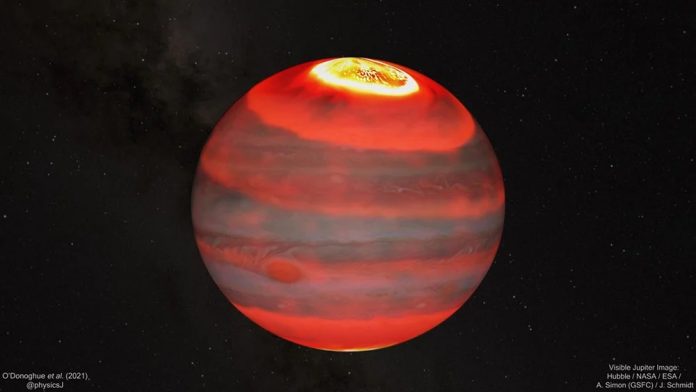
In the great tug-of-war between the Sun and its planets, Jupiter, Saturn, and Uranus are much more susceptible to solar activities than scientists thought.
Jupiter itself has an interesting reaction as it gets pummeled several times a month by solar wind bursts.
They compress its magnetosphere and create a huge “hot spot” with temperatures over 500C.
The first time scientists noticed this phenomenon was in 2017 and they’ve studied the planets since then to understand the mechanism.
“This is the first time we’ve ever seen a thing like this on any outer world,” said James O’Donoghue of the University of Reading in England.
He described the event as the solar wind squishing Jupiter’s magnetic field like a squash ball.
“This created a super-hot region that spans half the planet. Jupiter’s diameter is 11 times larger than Earth’s, meaning this heated region is enormous.”
Studies of this phenomenon show that the giant planets are vulnerable to solar wind events, just as Earth is. Here at home, the effects of this “space weather” range from something as gorgeous as auroral displays to power outages and communications systems failures.
Astronauts in space are particularly vulnerable to the radiation these solar outbursts send sweeping out into the solar system. Understanding these outbursts and the variable effects they have throughout the solar system gives valuable insight into efforts to predict them.
Jovian Aurorae
It’s well known that worlds with magnetospheres can exhibit auroral activity. When the solar wind slams into the magnetic field lines, charged particles in the solar wind smack into magnetic field lines, spiraling around them toward the poles.
They collide with atoms and molecules in the atmosphere and energize them. That causes them to glow in different colors, which creates the aurorae (the northern and southern lights). Energy gets dispersed in the form of heat.
Astronomers see aurorae on Jupiter, Saturn, and Uranus, and they occur on Mars as well as on Jupiter’s moon Ganymede. Jupiter’s aurorae are particularly interesting and have been tracked for years. Scientists used to think that they occurred mostly around the Jovian poles. That’s because of the winds spurred by the planet’s rapid rotation rate.
So, for a hot spot to occur after a solar wind burst that compresses the magnetosphere tells researchers that the planet’s atmospheric activity is susceptible to change. The result is global winds that drive energy from aurorae far from the poles to the equatorial regions.
Tracking Storm Impacts on the Big Planets
On Earth, we have a pretty well-developed system for tracking solar activities that could affect us.
There are satellites, solar telescopes, and other space probes that watch the Sun constantly. They track flares and coronal mass ejections that end up slamming into our own magnetosphere. We normally get a couple of day’s notice for any outbursts that look like they’ll impact our magnetosphere. With strong storm warnings, satellite operators, grid owners, and others can “safe” their systems.
The Jupiter “effect” that O’Donoghue and his team studied required multiple observations from the ground-based Keck II telescope in Hawai’i, plus data from the Juno spacecraft currently orbiting Jupiter.
The team combined that information with solar wind models to understand how the 2017 Jupiter hot spot formed. During that solar storm, there was a dense region of solar wind (which is made up of charged particles) that compressed the Jovian magnetosphere. That action produced highly intense auroral heating at the poles. Eventually, that heat spread out across the globe and spilled hot gases toward the equator.
This is unusual. Normally, the background temperature at Jupiter is about 350 C and there’s a temperature gradient that goes from higher levels at the poles to lower levels at the equator. That’s normally how auroral energy gets distributed across Jupiter. So, for a giant hot spot to appear like this 2-3 times a month indicates something is going on.
The team suggested in a paper that it’s possible the compression intensifies normal auroral heating and that drives the superheated region away towards the equator. They also suggest there could be some other activity that is creating the hot zone they see happening each month. It could be a stationary zone in the atmosphere, caused by a connection between the inner magnetosphere and the Jovian ionosphere.
The research team suggests further observations of solar wind effects on Jupiter and the other outer planets.
Not only will it help scientists understand the interconnections between different regions in the Jovian atmosphere and magnetosphere, but the data should contribute to better forecasting of storms that stir up space weather around the solar system.
Written by Carolyn Collins Petersen/Universe Today.



